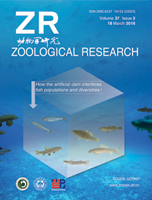
|
Zoological Research
Kunming Institute of Zoology, Chinese Academy of Sciences
ISSN: 2095-8137
Vol. 26, No. 5, 2005, pp. 499-505
|
 Bioline Code: zr05044
Bioline Code: zr05044
Full paper language: Chinese
Document type: Research Article
Document available free of charge
|
|
|
Zoological Research, Vol. 26, No. 5, 2005, pp. 499-505
| en |
Effects of Epidermal Growth Factor and Insulin on Biological Characteristics of Giant Panda ( Ailuropoda melanoleuca  ) Cutaneous Fibroblast in Vitro ) Cutaneous Fibroblast in Vitro
ZHANG Ming, HOU Rong, LIU Yu-liang, ZHENG Hong-pei, ZHU Qing, ZHANG Zhi-he, XIAN Hong
Abstract
Six culturing systems were designed by adding different concentrations of epidermal growth factor (EGF) and insulin into DME/Ham's F12 medium. Based on the speed of cell growth and variation ratio of chromosome number, we chose the best culture media from the six culture systems. The results showed that the culture medium of 10 μg/mL insulin and 40 ng/mL EGF was most suitable for giant pandas cutaneous fibroblast culture in vitro. In the best culturing system, the density of fibroblast increased from (1.673±0.185)x105/mL to 6.890x105/mL for three and a half days. The fibroblast growing speed was the fastest in all culture system and the ratio of diploid at the 5th generation was 75.77%. Karyotype analysis showed that culture cell is from Giant Pandas body cell. In conclusion, CS-5 is more suitable for giant pandas cutaneous fibroblast culture than other culturing systems in vitro.
Keywords
Giant panda, Fibroblast, Culture system, Epidermal growth factor, Insulin
|
| |
© Copyright 2005 Kunming Institute of Zoology, the Chinese Academy of Sciences
Alternative site location: http://www.zoores.ac.cn/
|
|
